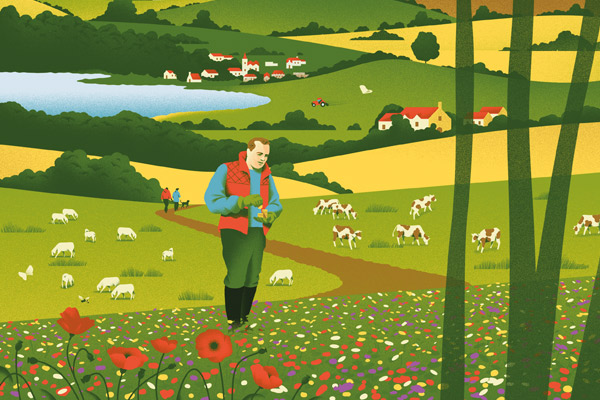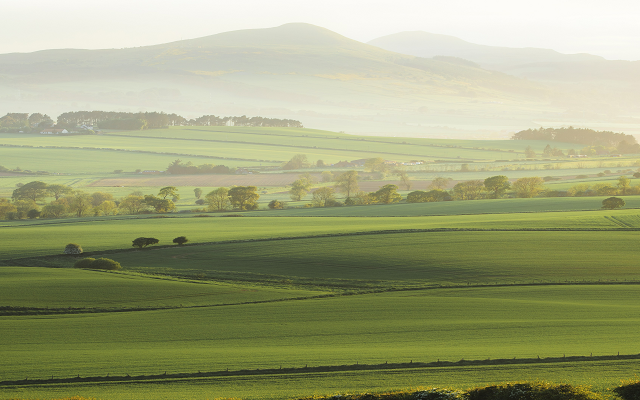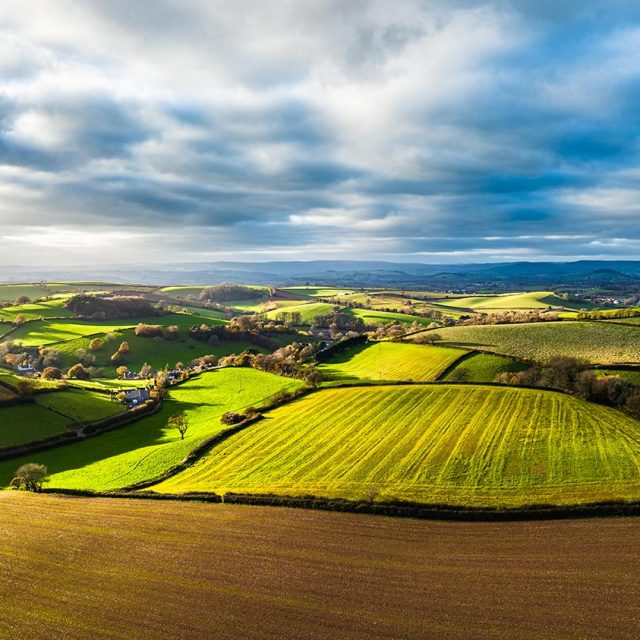Meet the natural capital pioneers
Natural capital has been a hot topic in the rural sector for more than a decade, but there is still confusion about what it is, what it involves and what it can deliver for farmers and landowners. We talk to three natural capital pioneers about how they are approaching it and why
Managing land with a focus on protecting and enhancing natural capital – the air, water, soil and ecosystems that support all forms of life – is becoming fundamental to the strategies of a growing number of farmers and landowners.
For some land managers the motivation is reducing their environmental impact, reversing declines in biodiversity and focusing on the many social benefits that nature restoration can offer.
Others are perhaps more focused on the financial gap opening up as direct payments are phased out and are exploring whether the management of natural capital assets could be an opportunity to generate new income streams.
But what’s really involved and what are the different approaches businesses are taking as they go on this journey to support wildlife and habitats, improve soil health and enhance the landscape?
Three natural capital examples
We’ve talked top three natural capital ‘pioneers’ who are looking at it from three very different viewpoints. They demonstrate how varied the opportunities and motivations are in this growing area of land management.
Nattergal – the nature recovery company
Nattergal is an example of a business with a bold vision for the future and ambitious plans to tackle biodiversity loss and improve natural processes at scale.
Only formed in October 2021, it’s a ‘nature recovery company’ with a difference. It has been set up to prove the concept that natural capital assets are worth investing in to deliver genuine commercial returns.
As one of the founders, CEO Neil Perry has already seen this happen. In his previous role working in the renewables sector, he says a tipping point was reached that made The City take the investment opportunities seriously. Perry’s vision is for natural capital to attract similar interest among investors, allowing the environment to reap the benefits.
‘Unless we get mainstream capital invested into it, we won’t be able to make a serious difference,’ he maintains. ‘Nattergal’s initial strategy is to buy lowland arable farms – that are ripe for ecological improvement and with lower quality soil – and carry out nature recovery to create natural capital assets – which includes environmental credits that can appear on a balance sheet.’
The company’s first site is Boothby Lodge Farm in Lincolnshire, a 605ha Grade 3 arable farm, sold by Strutt & Parker in late 2021. Nattergal’s plan is to continue to farm Boothby for the next three years, but inputs will be reduced over time. The company will then gradually take fields out of arable production to allow the process of natural recolonisation to begin.
In around five years, after a pulse of new vegetation appears, Nattergal will introduce free-roaming herbivores such as Longhorn cattle, Tamworth pigs and Exmoor ponies. ‘These animals will stop the land becoming a closed canopy forest,’ he explains. ‘For maximum biodiversity we need natural processes to function and a mosaic of habitats, creating a range of different environments beneficial for a range of species.’
While Nattergal is interested in carbon sequestration, where a market in voluntary carbon credits is growing, the company has a greater focus on biodiversity, which has a credit market still in its infancy.
There’s no external verification agency yet, although Perry sees this happening in the near future. However, there are already opportunities to benefit from the existing Biodiversity Net Gain (BNG) regime, which could form part of Nattergal’s revenue.
The question of how to monetise Boothby is obviously an important one, given the imperative to create an investment opportunity. Perry is hoping to adopt the following three approaches:
1. Eco-tourism. Sensitively planned and with minimal environmental or local impact, Boothby is looking to accommodate glamping alongside camping pitches, with nature safaris to attract visitors.
2. Carbon sequestration. With a baseline survey for carbon happening this autumn, the regeneration of the soil and woody vegetation will improve its ability to hold carbon and earn Boothby voluntary carbon credits.
3. Environmental credits. A baseline biodiversity survey was carried out in the summer of 2022, which will be used to measure the biodiversity uplift. The resulting voluntary credits can be sold to a number of corporates which are keen to achieve Net Nature Benefit or Nature Positive targets.
Nattergal’s aim is to buy two or three UK sites initially to provide proof of concept that nature recovery will provide sustainable financial returns. Once the investment opportunity has become evident, Perry is looking to grow the company internationally and expand into other natural assets, like marine.
‘Our measure of success will be to make as much difference as we can to biodiversity in this country and around the world,’ he concludes.
NECFC: A natural capital collective
In the Cotswolds a group of more than 100 farmers are taking on the challenge of improved environmental management by working together collectively to bring about change at a landscape scale.
‘The thing about the natural habitat is that it doesn’t respect farm boundaries,’ notes Tim Field, facilitator for the North-East Cotswold Farmer Cluster (NECFC). ‘A river will flow through many farms. Pollinators travel from one farmer’s crop to another.
That’s why, when landowners work as a group, they can be more effective in increasing the value of their own natural capital.’
The NECFC was formed as a Community Interest Company in 2021, to help landowners work together to achieve landscape-scale regeneration of the farmed environment.
It has grown to 113 farm members who collaborate and exchange valuable knowledge. This has led to a number of major projects over more than 35,000ha in the Windrush and Evenlode river catchments.
Working as a cluster offers benefits both in terms of environmental management and monetising natural capital. The power of group-thinking and purchasing is particularly valuable when it comes to preliminary work for projects like carbon capture, BNG and carbon trading. These could otherwise be prohibitively expensive. The cluster already has five farms assessing their biodiversity baseline ready to trade in BNG credits.
The Evenlode Landscape Recovery project is another shining example of the NECFC in action. A group of farms are collaborating to design, create and restore 3,271ha of interconnected habitat along the valley.
Among other benefits, this will hold water back in the catchment to help reduce downstream flooding; enable natural processes to filter and remove water pollution; and use ecosystem restoration to capture and store carbon from the atmosphere.
‘Many of our group have been integrating wildlife-friendly practices into their farming for decades,’ explains Field. ‘However, the galvanising of all 45 farms into such an ambitious, joined-up project will have far greater impact than the sum of individual projects in isolation.’
Field believes that the key to his role as facilitator is to understand each individual’s reason for becoming involved in the group. While some may want more trout in their river, others care deeply about the environment, and yet more need to monetise their land if they are to remain profitable. Yet leveraging the natural capital of the farmed environment can, in one way or another, provide the solutions for all, he says.
The Cholderton Estate. Natural capital through organic growth
The Cholderton Estate on the Wiltshire/Dorset border has been described as ‘one of the richest farmed estates in the country for biodiversity’ and held up as an example of best practice by Defra.
Henry Edmunds took over the running of the 1,000ha estate in 1975. As a knowledgeable naturalist, and Fellow of the Royal Entomological Society, Edmunds has managed the estate ever since as a working farm with a strong focus on biodiversity.
His interest in organic farming began before the term ‘natural capital’ had been coined. But, in essence, Edmunds’ principles have always embodied the idea. ‘Early on I realised that applying increasing amounts of fertilisers didn’t work,’ he explained. ‘The soil had lost virtually all its organic matter because pasture wasn’t being rotated.’
As soon as Edmunds began to include pasture grazed by sheep and cattle in his rotations, he saw an improvement in soil health and yield. He realised that traditional mixed farming was the way to go and when incentives were offered to become registered as organic, he was among the first in the queue.
The organic matter in his soil has been increased from 4% when he took over the estate to an average of 9.5% today. Considering that you need to add 100t of organic matter to raise the organic content of the soil by 1%, this is no mean feat. ‘Even during this year’s drought my spring barley was pushing 2t/acre, largely thanks to the fact that organic matter holds 90% of its weight in water,’ he explains.
Of course, organic mixed farming also offers many environmental benefits, which are of particular interest to Edmunds. Firstly, laying ground down for grazing sequesters carbon in large amounts. ‘We need to get cattle back onto pasture at the correct stocking rates, grazing legumes to keep the land in good order. It’s what they used to call The Golden Hoof,’ says Edmunds.
Cholderton’s mixed organic farming is also paying off in terms of biodiversity. On a single night recently, Edmunds counted over 200 different species of moth. Over the years he has also seen an increase in bird life and bee species, with 18 species of bumblebee recorded on the estate.
Edmunds has plans to increase the estate’s natural capital even further. He has applied for a grant to plant 25 acres of mixed native trees, layered with shrubs like honeysuckle, the larval food plant for the rare white admiral butterfly. He is also keen to reinstate a series of old dew ponds to bring even more life back onto the farm.
While he is a strong advocate for natural capital, Edmunds believes it has to sit comfortably within the practices of traditional mixed farming. ‘Relying on rewilding is the wrong approach,’ he insists. ‘We need to look at detailed management of individual fields, asking ourselves whether they are important areas of biodiversity and treating them accordingly. The plain truth is we need to manage all of our land better. Cholderton sequesters more carbon than it produces over the entire farming operation. Surely this is a benchmark the rest of the industry should follow?’
Making sense of natural capital
Duncan Glen, Strutt & Parker’s director of environmental land management, believes that the principle of natural capital has been greeted with a cautious optimism in the rural sector. ‘It’s quite a young science and there are many metrics jockeying for position, making it hard to quantify value,’ he says. ‘How do you put a figure on wellbeing? Or social value?’
But while the details are all still being worked out, there are clear signs that natural capital is developing as a credible income stream. Carbon credits are becoming established. A way to manage biodiversity credits is being worked out. And consultancies, such as environmental economists Eftec – which works with Strutt & Parker – are helping landowners answer some of the big questions.
Knowing where to begin can be the biggest challenge facing landowners. ‘A natural capital assessment of your land is a great place to start. The trouble is the ‘full fat’ version can be costly as there are so many metrics involved,’ says Glen. ‘We’ve already started discussions about a ‘lite’ version, which would be more affordable. We’re also helping landowners with payment stacking, where we can offer expertise in combining different financial initiatives.’
Testament to its potential importance is the way ever-more farmers are investing time and money in understanding what it is, what it involves and what it can deliver for them – and this, of course, at a time when they are grappling with accelerated change across so many aspects of their businesses. ‘This period of time in land management is unprecedented,’ concludes Glen.
PANEL 1
PRINCIPLES OF RESPONSIBLE ENVIRONMENTAL MANAGEMENT
Five key principles that should be applied to make natural capital projects a success.
1. Think broadly – consider both the positive and negative impacts on all four types of capital, which are economic, human, social and natural, when making any decisions.
2. It’s not just about carbon – carbon is just one issue to consider. Decisions should also consider energy, pollution, water quality and quantity, biodiversity, and food supply.
3. It’s not just about you – your decisions are likely to impact tenants, your neighbours and the local community. Engage with local communities about your plans, rather like you have to for major planning decisions.
4. Get your own house in order first – identify what is environmentally important on your property and make sure it is in good condition. Deal with your own current and future impacts before considering the sale of any environmental credits.
5. Sell well – if you are selling credits, sell high quality ones. You can do this by using high quality professional advice, using established codes and registers, and by using reputable brokers.
PANEL 2
WHAT ARE ENVIRONMENTAL CREDITS WORTH?
Woodland: Woodland carbon credits can be sold as Pending Issuance Units (PIUs) which are a ‘promise’ to deliver on a carbon unit in the future or as matured Woodland Carbon Units (WCU). Prices are highly variable with PIUs currently selling for £7-20/t of carbon sequestered and WCUs for £10-20/t. The English Woodland Carbon Guarantee provides an option to sell verified WCUs to the government for a guaranteed index-linked price every 5 or 10 years up to 2055/56. The average price is £20.37/t.
Peatland: Peatland carbon prices are stable at £15-20/unit for PIUs and a little more for matured peatland units. There is some evidence that buyers are willing to pay a premium of around £5/unit for units promoted as coming from high-quality restoration projects which can demonstrate biodiversity benefits as well as avoided carbon emissions.
Soil: A government-backed scheme is in development, but at the moment this market is based on a number of commercial schemes. Many schemes work on the basis of estimated change in carbon and prices remain in the mid £20s/t of carbon before scheme costs, which can account for around 50% of this amount.
To discuss any aspect of natural capital or environmental management, contact Duncan Glen. This article first appeared in our latest issue of Land Business. For more download the Autumn 22 edition of Land Business.






